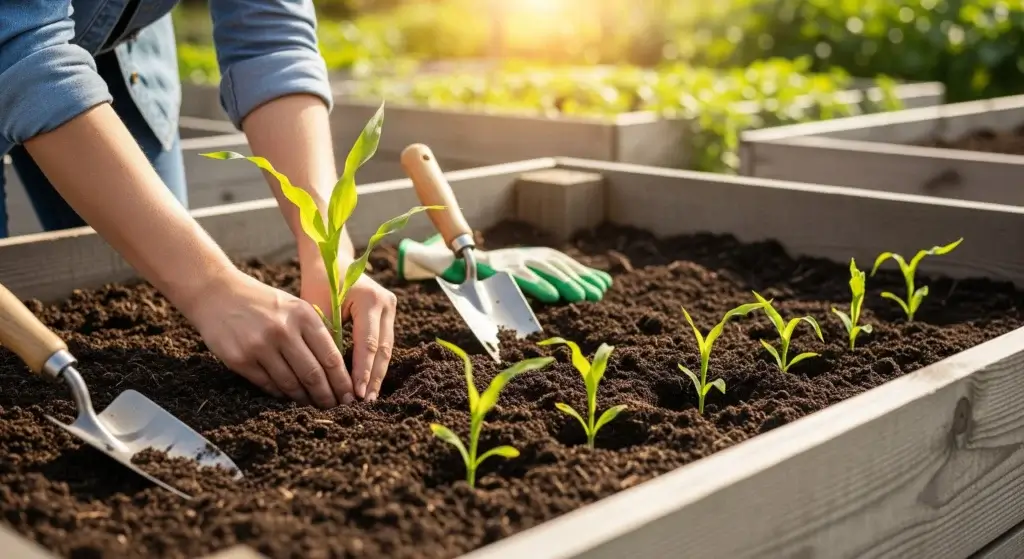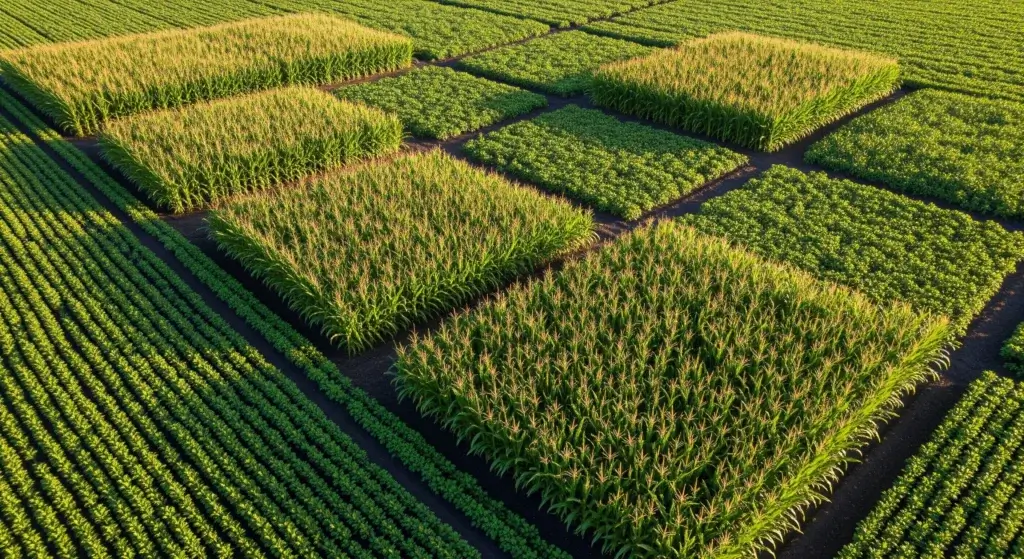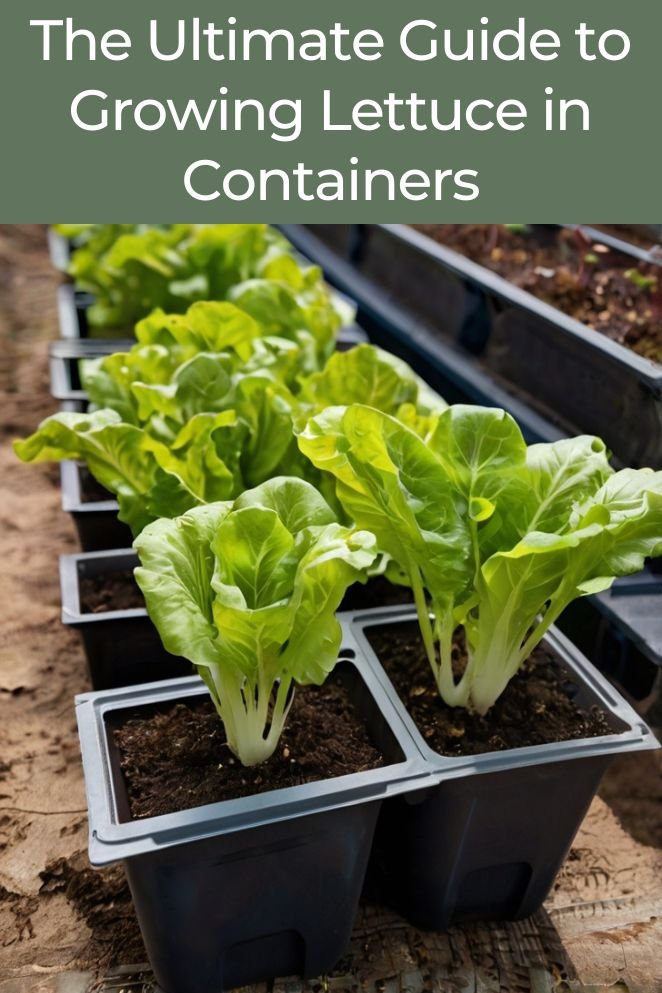
Growing lettuce in containers is a fantastic way to enjoy fresh, home-grown greens, even if you don’t have a traditional garden space.
Whether you live in an apartment with a balcony or have a small backyard, container gardening can bring you the joy of fresh lettuce all year round.
This guide will walk you through everything you need to know, from choosing the right container to harvesting your crisp, delicious lettuce.
Choosing the Right Container
The first step to growing lettuce in containers is selecting the right container.
Here are a few things to consider:
- Container size and depth: Lettuce doesn’t have deep roots, so a container that is 6-8 inches deep is usually sufficient. However, the width of the container can vary depending on how many plants you want to grow. For instance, a 12-inch diameter pot can comfortably accommodate three to four lettuce plants.
- Material: Containers come in various materials, including plastic, clay, and fabric. Each has its pros and cons:
| Material | Pros and Cons |
| Plastic | Lightweight, inexpensive, and retains moisture well. |
| Clay | More attractive but can dry out quickly and is heavier. |
| Fabric | Great for drainage and air circulation but may require more frequent watering. |
Make sure your chosen container has drainage holes to prevent waterlogging, which can lead to root rot.
- Read also: Caring Your Lettuce: How to Prevent Bolting in Lettuce Plants
- Read also: Tips for a Thriving Harvest: Watering Lettuce in the Garden
Preparing the Soil
Proper soil preparation is crucial for healthy lettuce growth.
Lettuce prefers a loose, well-draining soil rich in organic matter.
A good soil mix for lettuce should include the following components:
- Potting mix: Provides a base for your soil mixture that is light and well-draining. Commercial potting mixes are often made from peat moss, coir, and other organic materials. They are designed to retain moisture while allowing excess water to drain away, preventing root rot.
- Compost: Adds essential nutrients and improves soil structure. Compost is decomposed organic matter rich in nutrients. It enhances soil fertility and promotes healthy plant growth by improving soil texture and water-holding capacity.
- Perlite or vermiculite: Improves drainage and aeration in the soil. Perlite is a lightweight volcanic rock that helps keep the soil loose and airy. Vermiculite is a mineral that expands when heated and retains moisture while improving soil structure.
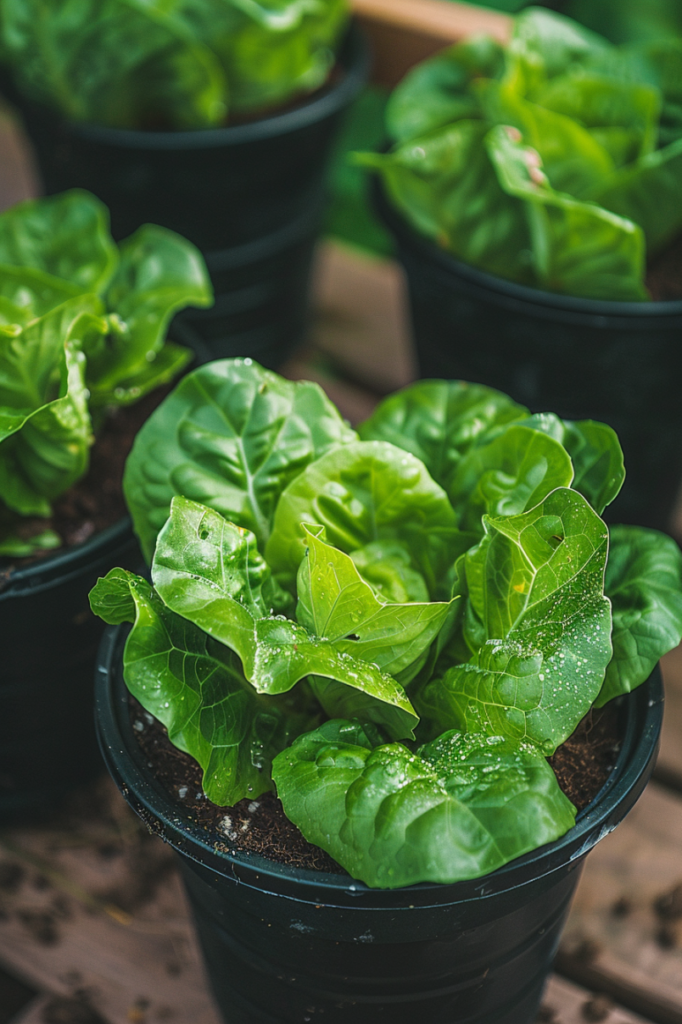
Lettuce Seeds or Seedlings
There are two main ways to get started with lettuce in your container: planting seeds or using seedlings. Here’s a breakdown of each method to help you decide:
| Method | Planting seeds |
Planting seedlings
|
| Pros | – More cost-effective, you get more lettuce for your money.
– Wider variety selection – you can find unique or heirloom seeds at nurseries or online. – Sense of satisfaction from nurturing the plant from the very beginning. |
– Faster harvest – you can enjoy lettuce much sooner, typically within 2-3 weeks of transplanting.
– Easier care – seedlings are already established and require less attention to germination. – No thinning needed – seedlings come ready-spaced, eliminating the thinning step. |
| Cons | – Takes longer to harvest – it can take 3-4 weeks for seeds to germinate and mature enough for harvesting.
– Requires more care – you’ll need to monitor moisture levels and ensure proper germination conditions. – Thinning is necessary – once seedlings establish, you’ll need to remove some to create proper spacing for healthy growth. |
– Less variety selection – nurseries might offer fewer lettuce seedling options compared to seeds.
– Slightly higher cost – you’ll pay per plant, whereas seeds provide more lettuce for the price. – Less control over the growing process – you’re relying on the nursery to raise healthy seedlings. |
Selecting Lettuce Varieties
Lettuce comes in several varieties, each with its unique characteristics.
Here are some popular types suitable for container gardening:
Loose-leaf varieties
Loose-leaf lettuces are excellent for container gardening because they don’t require much space and can be harvested continually, making them perfect for those who want a steady supply of fresh greens.
- Salad bowl: Bright green, deeply lobed leaves. Easy to grow, quick to mature, and very tolerant of heat. You can start harvesting the leaves when they are young, and continue to pick outer leaves to encourage new growth.
- Black seeded simpson: Light green, frilly leaves with a mild flavor. Fast-growing and does well in both cool and warm conditions. Ready to harvest in just a few weeks, and you can pick leaves continuously.
Heading varieties
Heading varieties take a bit longer to mature but can also be grown in containers.
They form a dense head and are known for their crisp texture and distinct flavor.
- Butterhead: Soft, buttery-textured leaves with a sweet flavor. Prefers cooler temperatures and requires consistent moisture for best growth. Typically takes about 55-75 days to mature, but you can harvest outer leaves earlier.
- Romaine: Tall, crunchy leaves with a slightly bitter taste. Thrives in cooler weather and needs ample sunlight. Takes about 70-85 days to form a full head, but young leaves can be harvested earlier.
Cut-and-come-again varieties
Cut-and-come-again lettuces are incredibly productive because you can harvest them multiple times.
This type of lettuce allows you to cut the leaves, and they will regrow for another harvest.
- Oakleaf: Lobed, oak-like leaves that are tender and flavorful. Grows quickly and is very forgiving of various growing conditions. Harvest leaves as needed, and they will continue to grow back for several weeks.
- Lollo rossa: Frilly, red-tinted leaves with a mildly bitter taste. Prefers cooler temperatures and does well in partial shade. Leaves can be cut continuously as the plant grows, providing a steady supply of fresh lettuce.

Planting Lettuce in Containers: Step by Step
Planting lettuce in a container is a great way to grow your own fresh greens, especially if you have limited space.
Before planting lettuce in a container, gather the necessary materials, such as:
- Lettuce seeds or seedlings
- Container with drainage holes (at least 6-8 inches deep)
- Soil: potting mix
- Watering can or spray bottle
Here’s a step-by-step guide to help you get started planting lettuce in containers:
Step 1: Fill the container
Fill the container with the potting mix, leaving about an inch from the top.
Lightly tamp down the soil to remove any air pockets.
but avoid compacting it too much as this can impede root growth and water drainage.
Step 2: Sow the seeds or plant seedlings
- If using seeds, sprinkle them evenly on the soil surface. Lettuce seeds are tiny, so try to space them out as evenly as possible. Cover the seeds with a thin layer of soil, about 1/4 inch deep.
- If using seedlings, make small holes in the soil, gently place the seedlings in the holes, and cover the roots with soil. Space the seedlings about 6-8 inches apart to allow room for growth.
Step 3: Watering
Gently water the soil after planting to settle the seeds or seedlings.
Water the container thoroughly until water runs out the drainage holes. Use a watering can or spray bottle to avoid disturbing the seeds or seedlings.
Aftercare
Ensuring your lettuce thrives in a container requires proper aftercare. Here’s a breakdown of the steps:
- Watering: Lettuce thrives on consistent moisture, but avoids drowning the roots. Aim to water deeply when the top inch of soil feels dry to the touch. Water slowly and directly to the soil, avoiding splashing water onto the leaves. This helps prevent the spread of diseases.
- Sunlight: Place the container in a location that receives at least 6 hours of sunlight daily. However, during very hot afternoons, some shade can be beneficial, especially for summer plantings.
- Thinning (for seeds): Once seedlings reach 2-3 inches tall with 4 leaves, it’s time to thin them out. Gently remove weaker plants, leaving the strongest ones spaced according to your lettuce variety. Refer to the seed packet instructions for specific spacing recommendations. You can transplant the thinned seedlings to another pot if you have space.
- Fertilizing (optional): You may not need fertilizer for lettuce, especially if your potting mix is already nutrient-rich. However, if the growth seems slow, a light application of a balanced fertilizer diluted according to package instructions can be done every few weeks.
- Mulching: To help retain moisture and keep the soil cool, you can add a layer of mulch around the base of the plants. This is especially useful in warmer climates.
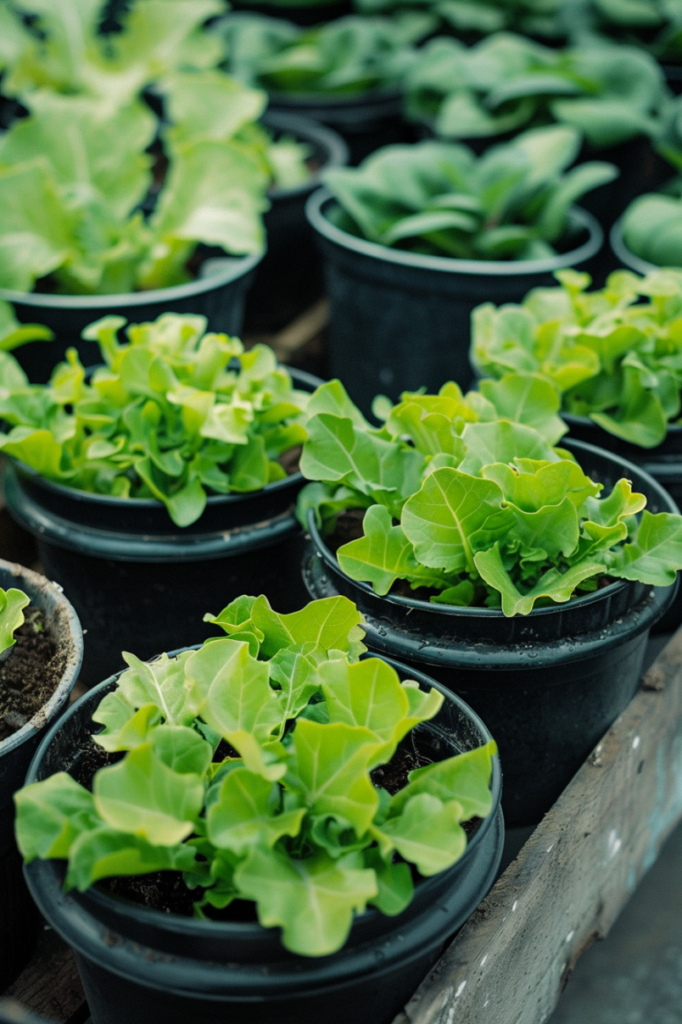
Harvesting Lettuce
Knowing when and how to harvest your lettuce ensures you get the freshest, most flavorful leaves.
Here’s a detailed guide to help you harvest different varieties of lettuce.
When to harvest
- Loose-leaf varieties: Loose-leaf lettuce varieties are among the easiest to harvest and offer a continuous supply of fresh leaves. You can begin harvesting loose-leaf lettuce as soon as the leaves are large enough to eat, typically when they reach about 3-4 inches in length. Look for vibrant, healthy leaves. Avoid harvesting leaves that are yellowing or wilting.
- Heading varieties: Heading lettuce varieties take a bit longer to mature but offer a rewarding harvest with crisp, well-formed heads. Harvest heading varieties when the heads are firm and fully formed. This usually takes about 70-85 days, depending on the variety and growing conditions. The head should feel dense and firm to the touch. If the head is still loose, give it more time to mature.
How to harvest
Harvesting loose-leaf varieties
Loose-leaf varieties can be harvested in a way that allows the plant to keep producing new leaves.
- Use a pair of sharp scissors or garden shears to cut the outer leaves of the plant. Leave the central leaves intact so the plant can continue to grow and produce more leaves.
- Cut the leaves about 1 inch above the base to avoid damaging the plant’s growing point. This method, often called “cut-and-come-again,” allows for multiple harvests throughout the growing season.
Harvesting heading varieties
When harvesting heading varieties, the entire plant is typically harvested at once.
- Use a sharp knife or garden shears to cut the entire head of lettuce at the base, just above the soil line.
- Make a clean cut to ensure the remaining stem can potentially sprout new leaves. However, most heading varieties are harvested once, and the plant is not expected to produce again.

- Read also: Watering Lettuce in Pots: A Simple Guide for Beginners
- Read also: Growing Green: A Guide to Natural Pesticides for Lettuce
Conclusion
Growing lettuce in containers is a rewarding and straightforward way to enjoy fresh greens at home.
By choosing the right container, selecting suitable lettuce varieties, preparing the soil properly, and maintaining your plants, you can harvest crisp, delicious lettuce throughout the growing season.
Happy gardening!
FAQs
The size depends on the lettuce variety. Loose-leaf lettuce thrives in shallower containers (at least 6 inches deep and 8 inches wide), while head lettuce needs more space (12 inches deep and wide).
Opt for a well-draining, high-quality potting mix designed for container gardening or vegetables. Adding compost to the mix provides extra nutrients.
Seeds are cheaper and offer more variety but take longer to harvest. Seedlings provide a quicker harvest but may have limited variety. Choose based on your experience and desired harvest time.
Water deeply when the top inch of soil feels dry to the touch. Avoid overwatering, as soggy roots can lead to rot.

